5 must-have email campaigns for online store
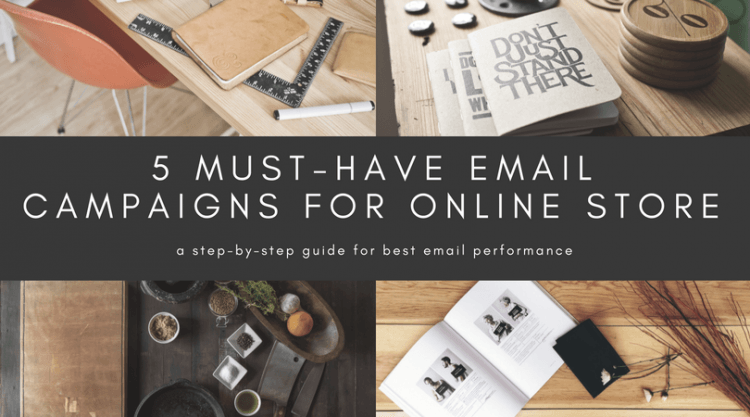
Email is still one of the most important channels in successful online selling, especially when you just start your online store and have a tight budget for marketing. Email has a variety of usage. Whether you want to welcome new shoppers, offer them enticing deals and discounts, remind them about the products they’ve abandoned or any of our innovative strategies above, email marketing is a very powerful tool. But due to its versatility, it is complicated for beginner to find a starting point for their emailing campaigns. We have found 5 emails that every e-commerce store must have. If you are an online retailer and new to email marketing, it is for you.
Welcome email
It must be familiar to you to receive welcome emails, but you might be shocked by these statistics “The average open rate for welcome emails is a whopping 50%” (Marketing Sherpa) and they typically have 4x open rate and 5x the click-through rate of other mailings (Experian). Retailers that send a series of welcome emails see 13% more revenue than those that send just one. (Internet Retailer 500). Welcome email is a real chance; you should let people know about you right when they’re most interested in hearing from you.
Checklist for welcome emails:
Target: Newly-registered email subscribers or first-time buyers
Timing: a few minutes after email subscription or first purchase (The delay is critical: it makes customers feel the email is not an automatic email but a real welcome from a real person)
Content: In your “Welcome Email”, you should let them know more about you, enough to build trust and interest about you. You should send it from the store founder’s personal email address, not the general sales or support emails
Additional advice: You should limit your email content to a readable length. If you have so many things to say, please send your email in a series, but try to avoid bombarding your customers with your emails. No one likes a person that keeps talking about himself all the time.
Cart abandonment emails
Cart abandonment is a real disaster, but it happens. If you are in any online retailer society, I bet you will hear about it all the time. And the number one advice from experts is always about following up emails. These emails will act as reminders to bring shoppers back to complete the purchase.
It is simple and it works. According to a Marketing Sherpa survey of over 2000 Americans, 51% of people who ever left an item in an online shopping cart find reminder emails helpful with 6% saying they always complete the purchase after receiving the message.
Here is an example from SimplySupplements. They not only reminded me that I still have items in my cart but they also offered me free delivery and free return as an incentive to complete my purchase.
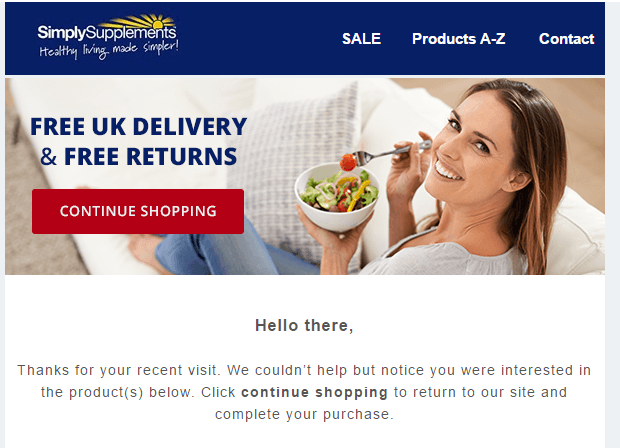
Checklist for cart abandonment emails:
Target: Added Item to Cart but didn’t check out users
Timing: 1-3 hours after the Added Item to Cart event is tracked depending on your site’s average shopping time
Content: preview of items in cart and link to check out (you can also add personalized recommended items in your email)
Additional advice: If the first email didn’t work out. You can send another one after 24 hours, possibly with an incentive like discount offer. And it is also effective to send them other personalized recommended items as in Dot & Bo example below.
Cart abandonment emails have an average open rate of 30%, and revenue per email is between $1-$3. Adding the second or third email can be quite effective as Dot & Bo saw a 400x increase in campaign revenue with a two-step abandoned cart workflow.
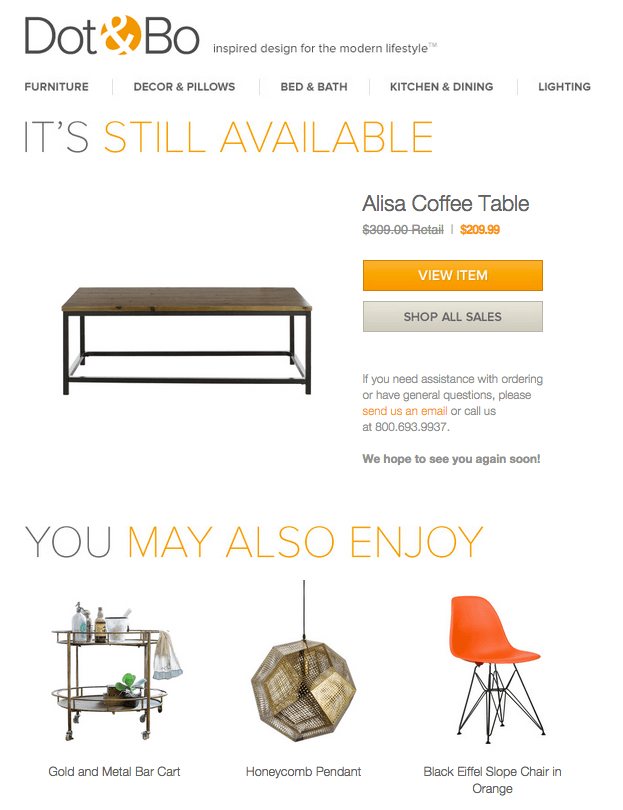
Purchase confirmation and shipping
These emails reaffirm your customer that their order is succeeded and it is looked after now. They are really important in terms of customer care. It is even more crucial when you find out that
For every 100 receipts you send, you can make an average of $25 of extra revenue with no extra effort. (Conversio)
Not bad for an automated email, huh?
While the order confirmation email is an additional way of utilizing the above (such as offering discounts, encouraging engagement, etc), it’s also a way of pacing your customer’s expectations. Here is SimplySupplement dispatch comfirmation email, which I found a good example. 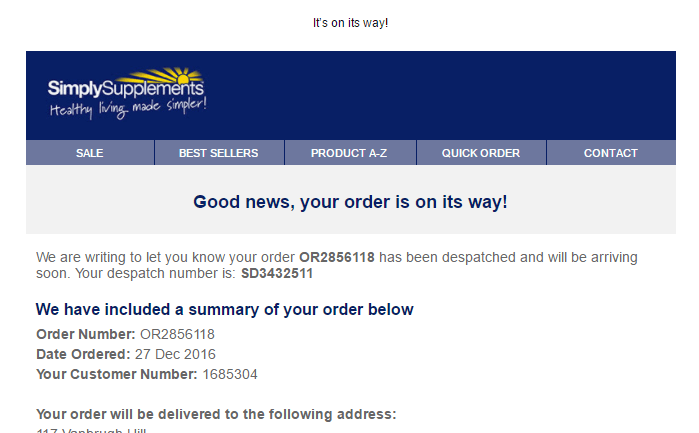
Checklist for purchase confirmation and shipping emails:
Order: order confirmation, dispatch confirmation, out for delivery, delivered
Target: checked-out customer
Timing and content: Rights after these actions are taken:
- Check out: send them an order confirmation as a receipt and expected arrival date.
- Order is dispatched and out for delivery
- Order is delivered
Additional advice: It depends on your business that you should send all these above emails or not. But the whole idea is that you tell your customer to relax and wait for their items to arrive. You can also take advantage of these emails to upsell or cross-sell.
Retention
Yes, it happens. Some of your customers just don’t come back. Either they’re a massive fan and purchases again every week or more likely, they’ll fall off the grid within a few months. Obtaining a new customer is 5 times more expensive than keeping an old one. So you have to make extra effort to bring them back by implementing the retention email campaign.
On average, we see open rates of 25-35% e-commerce companies. It’s always worth reminding previous customers you’re still thinking of them (even if they’ve moved to a competitor). Here is an exmaple from Memebox.
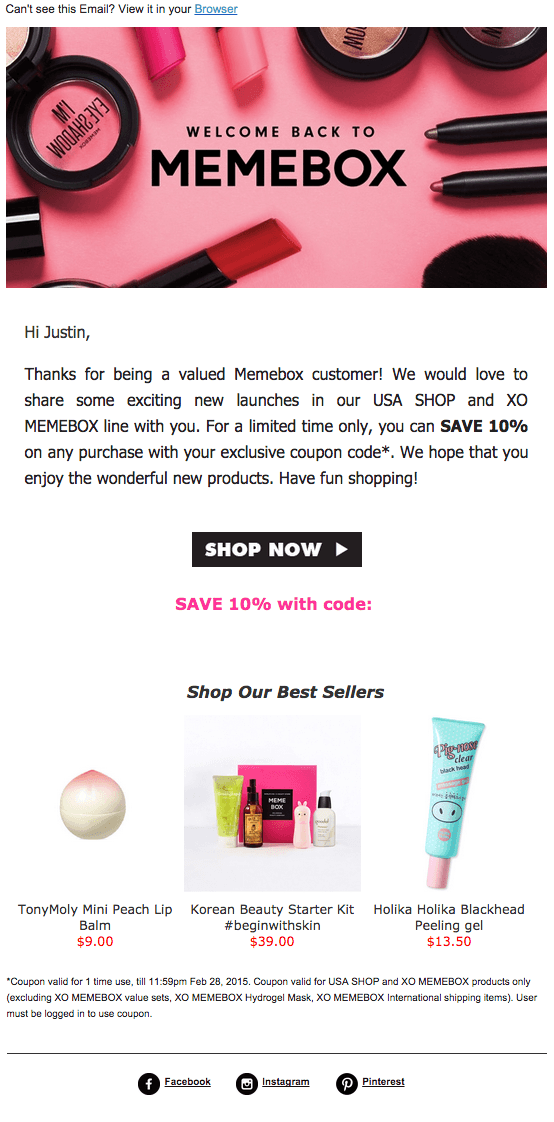
Checklist for retention emails:
Target: inactive users or customers in a period (about 30 days for an online store)
Timing: when 30 days has passed since last purchase
Content: latest items or re-engagement offer (coupon code, items, new features) invites dormant users to come back and rediscover why they fell in love with your product or store
Additional advice: Repeat every month. Wait 1 day. If email is not opened, send another email or push notification. Repeat every month.
Date triggered email
Only 24% of online businesses send date triggered emails such as delighting customers with birthday greetings and other anniversaries like membership subscription date (Internet Retailer 500). According to ClickZ, birthday email can lift conversion rates by 60% over other email messages with the same offer. These emails make your subscribers feel special and give them a reason to spend that extra birthday money with you. It is also a good way to warm up your relationship with customers.
Like real birthday or anniversary celebrations, you should offer your shoppers a gift that they can’t pass up like discounted items or a free gift with their next purchase (See how to do it with Bogos Free Gifts App). This way you are adding sales while celebrating an important occasion with your shoppers.
Checklist for date triggered emails:
Target: Birthday celebrants and membership anniversaries
Timing: Consider sending the following sequence:
– A pre-email, few days before the event
– The day of the event itself
– A post-email, few days after the event
Content:
– Be sincere and in a celebratory mood
– Include a compelling call-to-action like “Treat Yourself” or “Pamper Yourself”
– Create sense of urgency by offering discounts and freebies
Additional advice: The more personalized the email is, the better result it can conduct. So, you can try offering your customers with the customizable products or the one that recommended for them.
>>>8 Steps to Set Up a Mobile-Friendly Shopify Email Marketing Campaign
Conclusion
Finally, emails that get opened and clicked through are those that are tailored to suit the recipient’s interests. The extent to which an email is personalized, defines the ROI the channel is able to generate for you. These 5 automated emails above are a good start.
